Cherry Valley History
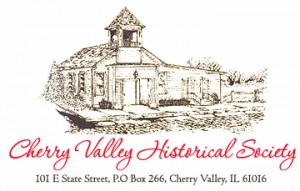
Email us at cvhs.1899@gmail.com
CHERRY VALLEY’S BEGINNINGS The first permanent settler, at what is now Cherry Valley, was Joseph P. Griggs. He built a house on the west side of the river in 1836. He was followed by a Mr. A. C. Gleason and his brother Mr. W. Gleason, and in 1837 by S. W. Gleason and Densly Kizer. Mr. Griggs and his son Calvin built a grist mill on the west side of the river and also operated a boat to ferry travelers across the river in high water. The small settlement was known as Griggs Ford.
At that time Cherry Valley township was known as Butler Precinct until the stage coach mail service began and it was determined that there was another Butler in Illinois. Names were drawn from a hat and Cherry Valley was drawn. This name was placed into the hat by a lady who previously lived in Cherry Valley, New York.
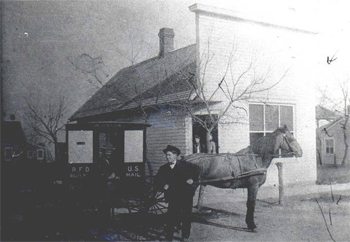
The Cherry Valley Post Office – 1908
About the same time that Cherry Valley was settled, another settlement was established about a mile and a half up the river. This was called Newburg. This is where Newburg Road crosses the Kishwaukee River today. Both settlements had a hotel, a gristmill, general stores, and blacksmith shops. Newburg, at one time, had a chair factory.
Both settlements prospered until the Chicago and Galena Union Railroad began to build its line from Chicago to Rockford. Both villages wanted to be a station but when a group of Belvidere citizens lead by W. H. Gilmon procured a right of way on the south side of the Kishwaukee River, it was decided to cross the river at Cherry Valley leaving Newburg a mile off the line.
The citizens of Newburg were quite unhappy about this and referred to Butler and afterward Cherry Valley as “grab-all”. Newburg then went into a decline and by the end of the civil war, it had disappeared. The mill was torn down in the 1880’s and the hotel in the 1890’s. Today there is a farmhouse on Shaw Road that dates back to the days of Newburg. Part of the mill race along Beaver Creek is still visible.
With the coming of the railroad Cherry Valley became a shipping center for the area. At one time it had three grain warehouses (elevator), stockyards, two hotels, and a busy business district. In about 1850 a new grist mill was built on the west bank ofthe river at the foot of a mile long millrace. This ran along the foot of the hill below the cemetery. The dam was located where the toll road crosses the Kishwaukee River.
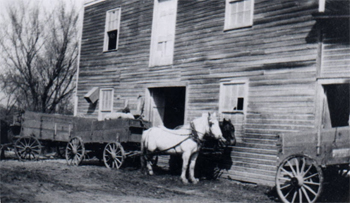
Team and wagon at the Old Mill – 1914
The mill produced flour and also ground feed for area farmers. About 1900 an electric generator was installed at the mill to produce power for the electric lights for the village. This was run by water power. About 1905 an engine was installed in the mill to run the mill and generator when the river was low or in flood. The quarry on the west side of the mill road was flooded at one time and a barge was loaded with stone to be poled up the race to the dam when repairs had to be made.
About the time of WWI a tornado wrecked the third floor of the mill and a flat roof was installed on the second floor. Also at this time the stone buhrs were removed and modern feed grinding machinery was installed to grind animal feed. The mill ran on water power as late as 1940. In 1951 the machinery was removed and most of the building was torn down. In 1963 what remained was burned and the site became the turn lane at the west end of the bridge. The waste gate is still in place that was used to devert the millrace when work was necessary on the turbine. This is north of the west end of the bridge along with an iron ring in the cement wall where the maintenance barge was tied.
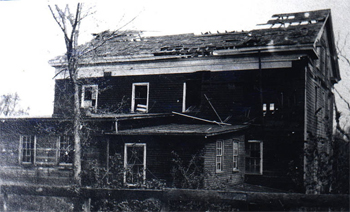
Tornado damage at Old Mill – 1918
In the late 1840’s Cherry Valley had two school houses. White School located on the east side of the river on the village green for the younger students, and Brown School located on the hill on the west side of the river for the older students.
In 1859 a new school house, three stories high, was built at the east edge of the village. It had three classrooms on the first floor, three classrooms on the second floor, and a large auditorium on the third Hoor. There was a high tower on the north west side of the building with a large, fancy belfry on top. For years this was one of the finest school buildings in this area.
In 1938 a gymnasium was built to the south side of this building. In the middle 1950’s the 1869 portion of the building was raised in a two stage program and new classrooms were built.
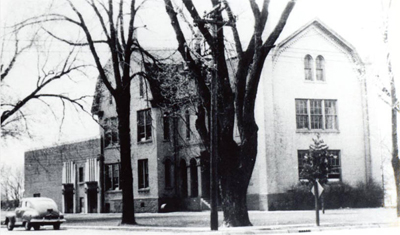
Cherry Valley School with Gymnasium Addition – circa 1940
In 1869 a fire destroyed most of the business district on the south side of State Street. It was soon rebuilt of brick which was made in a kiln on the west side of the river, south of the rallroad. The new school house was also built of these bricks.
At one time broom corn was an important crop in the area and two local farmers John Brown and Hugh Macky each grew about three hundred acres which gave employment to fifty to sixty men. In the 1880’s the wage for hoeing broom com was one dollar a day for adults and fifty cents for children.
From the time the railroad came through until 1890’s Cherry Valley remained unincorporated, though a busy trade center. In February of 1896 a petition was circulated amongst the three hundred residents of section one of Cherry Valley township. This was a square mile containing the village and signed by:
| B.E. Brown T.W. Lee Oscar King L.W. King Wm. Slater, Sr. L. Stringer E.J. Carlson Garrett Healey Luke Kehoe Wm. P. Buck D.M. Packard | F.E. Stockwell B.H. Bean F. Garrett S.W. Shirley H.D. Traveller W.P. Woodard H.H. Traveller C.H. Noel N.N. Akerly J.H. Jeffrey W.W. Adams | L.A. Stringer F.O. Peterson G.F. Cromer Fayette Adams C.R. Kling J. Johnson Andrew Culhane Luke Burke W.J. Slater G.A. Crosby |
This petition was presented to Rufus C. Bailey, Judge of Winnebago County Court; to organize Cherry Valley as a village. On March 17, 1896 an election was held in Sanborus Hall with T. M. Lee, S. E. Hall, and Oscar King as judges. By a vote of eighty to twenty-four the Village of Cherry Valley was allowed to organize.
Submitted by John Larson, Cherry Valley Historical Society
